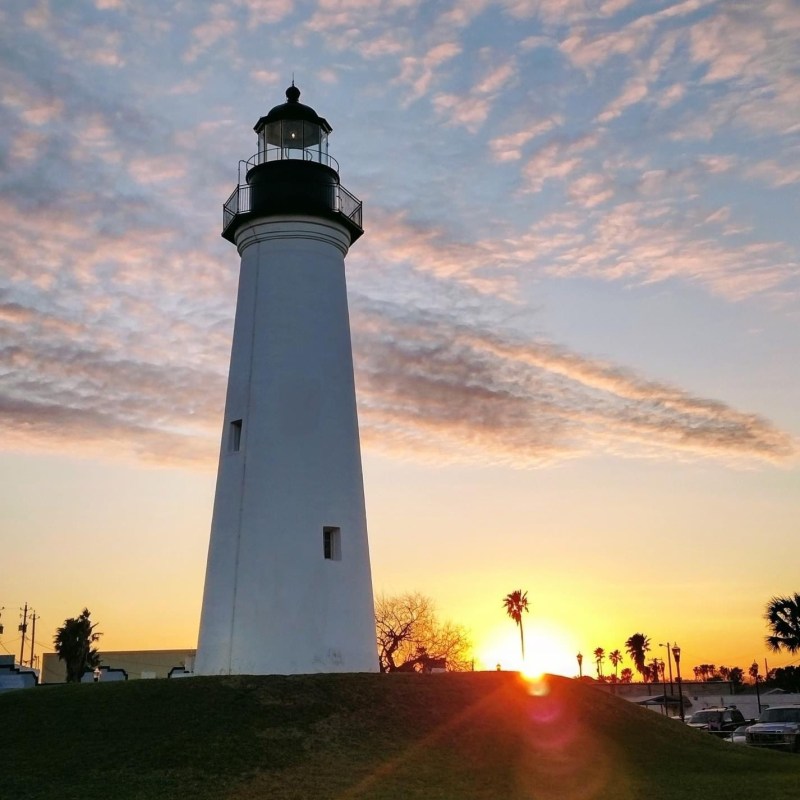
The Tropical Trail Region of Texas extends from the Rio Grande River to Gulf of Mexico coastal cities like Corpus Christi, Port Aransas, Port Isabel, and South Padre Island in the state’s southernmost region. The expansive region covers 23,000 square miles and 20 counties, from Aransas to Zapata. A vast variety of architectural, cultural, and historic landmarks are featured. Miles of public beaches invite hiking, fishing, and boating for the more adventurous, while less strenuous activities — visiting historic landmarks, museums, or wildlife preserves — offer a more relaxing trip.
Videos by TravelAwaits
Over the past 20 years, my husband and I have spent many memorable vacations in Texas’ Tropical Trail Region. Some but not all of our trips were sponsored or partially sponsored by destinations. Here are my recommendations for historic places to visit and incredible sights — some off the beaten path — that you don’t want to miss!

1. Aransas County
This county has great birding, boating, wildlife, and nature preserves on Aransas Bay.
Adjoining coastal resort towns Rockport and Fulton feature miles of hiking and biking trails ranging from an easy 1.08-mile hike to a 40-mile bike ride, plus public fishing piers and marinas with fishing or bird-watching boat tours available. Hurricane Harvey made landfall in Rockport in August 2017, but residents performed miracles rebuilding this tropical habitat that welcomes hummingbirds and whooping cranes, drawing bird watchers from around the world.

Fulton Mansion
Fulton Mansion, a stately 150-year-old architectural marvel overlooking Aransas Bay, is a short distance from the busy harbor. A state historical site, the lovingly restored mansion opens daily for self-guided tours. An amazing example of Colonel George Fulton’s engineering genius, the four-story house featured indoor bathrooms, flush toilets, and heating systems far before its time. Tours take 2 to 5 hours and involve climbing stairs to the upper floors. The best time to visit is the Christmas holiday season, when costumed docents demonstrate how an affluent family celebrated the holiday in the Victorian Era.
Lighthouse Inn
The Lighthouse Inn on Aransas Bay, with a Victorian-era design and overlooking the water, is a great place to stay. Each room has a private balcony or patio, and the staff dispenses real Southern hospitality to their guests.
Charlotte Plummer’s Seafood Restaurant
Charlotte Plummer’s Seafood Restaurant at Fulton Harbor is the place for locally caught seafood. Sit outside on the balcony deck and watch fishermen and shrimpers bring in their haul while you dine. They also have a well-stocked bar.
HummerBird Festival
The HummerBird Festival in September draws enthusiastic crowds to greet the tiny avian travelers. Reservations are required months in advance since hotel rooms sell out. Birders also flock to see once-endangered whooping cranes that nest in Aransas Bay from November to March.

Pro Tip: Book a whooping crane trip on Captain Tommy’s “skimmer” out of Fulton Harbor. Landlubbers might try their luck at Aransas Wildlife Refuge or on Goose Island, accessible by car or boat. The Big Tree, a beloved historic landmark that’s been often photographed by visitors, is also on Goose Island.
2. Cameron County
On the Gulf of Mexico, Brownsville is the county seat. Sun seekers flock to South Padre Island and Port Isabel from March to October, and snowbirds (aka “winter Texans”) congregate here from November to February. The coastal resort towns are separated by the Queen Isabella Causeway.
On South Padre Island, enjoy pristine beaches plus boating, fishing, surfing, or shell hunting at this island town with a “cool” vibe. The island boasts a number of hotels or camping options, a wide variety of restaurants, and a lively entertainment district.
Isla Grand Resort Hotel
The best place to stay is the Isla Grand Resort Hotel. Cabana rooms provide Gulf and pool views, plus excellent entertainment nightly.
Cafe On The Beach
The best restaurant for breakfast is Cafe on the Beach, located behind the Palms Resort. Under new ownership, this popular place features a gourmet menu (my eggs Benedict Florentine were delicious). Prices are reasonable too, and lunch, happy hour, and dinner service have been added to the menu.
Pro Tip: If you’re wary of birds, ask for a table at Cafe on the Beach that’s at a distance from the scenic view tables. It’s an open-air restaurant, so birds perch on the back sill to watch for leftovers.

Port Isabel Lighthouse
Port Isabel is famed for its 72-foot-tall lighthouse, an impressive structure built in 1852 to guide ships coming there through the Brazos Santiago Pass. The National Historic Site Port Isabel Lighthouse is the state’s only lighthouse open to the public. Tours require visitors to be physically able to climb 75 winding stairs plus three ladders to reach the top, where you’re rewarded with amazing views. After installing a 3rd order Fresnel lens in the top of the lighthouse lantern room, a December 9 celebration marked the first official lighting of the historic lighthouse in 117 years.
Pro Tip: Unable or unwilling to climb all those stairs? Check out Port Isabel’s lively Lighthouse Square with pedestrian-friendly boutique stores, museums, and the state’s longest fishing pier all within easy walking distance. Enjoy scenic water views with seafood or Tex-Mex specialties at Pirate’s Landing on the pier.
3. Nueces County
Corpus Christi, the County Seat, is the eighth most populous city in Texas (population 317,863 in 2020), located about 130 miles southwest of San Antonio. City limits extend into three other counties (Aransas, Kleberg, and San Patricio). The Port of Corpus Christi is the fifth largest U.S. port. Corpus Christi features a wide range of activities like boating, camping, and fishing as well as entertainment with a variety of restaurants and nightlife.
Texas State Aquarium
Texas State Aquarium in Corpus Christi promotes the conservation and rehabilitation of wildlife from the Gulf of Mexico. Recently applauded for their efforts to save turtles during Winter Storm Uri last February, the aquarium also added a Caribbean Journey expansion that includes a jungle aviary and a 400,000-gallon shark exhibit.
Port Aransas And Mustang Island
Nearby cities and islands like Port Aransas and Mustang Island offer beach and water lovers additional choices year-round. Port Aransas/Mustang Island features the most unique place to stay in the area. The historic Tarpon Inn in Port Aransas, circa 1887, features 200-foot-long porches and Key West-type architecture.

4. Hidalgo County
McAllen is the largest city, and Edinburg is the county seat of this Rio Grande Valley county. But the tiny town of San Juan is worth leaving the beaten path to discover its inspirational new art museum.
Gelman Stained Glass Museum
Gelman Stained Glass Museum in San Juan showcases a breathtaking assembly of stained glass. A local doctor compiled the extensive collection of stained glass windows primarily found in old church buildings. The museum opened last spring, and the interior has a sacred ambience like being in a cathedral or other place of worship.
The Basilica of Our Lady of San Juan del Valle is another lovely local sanctuary that’s available for tours.
5. Jim Hogg County
Hebbronville is the county seat. This town is located off the beaten path but is worth a special trip just to visit its beautiful cathedral, Our Lady of Guadalupe, or the Franciscan Garden and Museum. Hillcrest Tortillas & Bakery, a family-owned and operated tortilla factory, is also worth a visit.
6. Kleburg County
King Ranch
Shuck your beach attire and flip-flops for boots and jeans to soak up cowboy culture in Kingsville, the Kleburg County seat, 45 miles inland from Corpus Christi. It’s home to the 825,000-acre King Ranch founded by Richard King in 1853, one of the largest working ranches in the world.
The King Ranch takes up most of Kleberg County, much of Kenedy County, and extends into Brooks, Nueces, and Willacy counties.
King Ranch Visitor Center has information on ranch tours, and King Ranch Museum in Kingsville offers a look into Texas’ storied past with a visit to an era when Cattle Barons were kings in Texas.
7. Live Oak County
Oakville
This Coastal Bend county’s seat is George West, but the unincorporated town of Oakville has become a popular tourist destination. With a historic post office and the Live Oak County Jail both on the National Register of Historic Places, visitors can take a step back in time in this Texas Historic Landmark town.
Live Oak County Jail
Chartered in 1856, Oakville boasted a bustling population of 400 at its peak, with seven saloons entertaining and supplying booze to the cattle drovers heading up the Chisholm Trail. Many of them ended up sleeping off their drunken stupors in the Live Oak County Jail.
After the Civil War, lawlessness became rampant and they needed a sturdier jail than the first two clay and wooden structures. In 1887 an imposing two-story building was constructed from sandstone blocks. Live Oak County Jail operated until 1919.
In 2007, restoration of the historic jail building was completed, which spurred the restoration of more of the older buildings on Oakville Town Square.

8. Webb County
Laredo
Laredo, the Webb County seat, is located on the North bank of the Rio Grande, with Nuevo Laredo just across the river in Mexico. As the largest inland port of entry in the U.S., Laredo is a blend of two cultures.
Sandy Jumper, Executive Director of the Texas Tropical Trail Region, says they are planning to celebrate their 200th TTR partner event with many exciting activities in Laredo, February 21–22 during the month of George Washington’s birthday. For more details, email info@TexasTropicalTrail.com.
Mexican Restaurants
On both sides of the border, you’ll find delicious, authentic Mexican food. Some of the best-rated Mexican restaurants in Laredo are Charlie’s Corona, Las Kekas, El Capataz, El Quinto Sol, and Palenque Grill Loop 20.

9. Zapata County
This county is named for Col. Jose Antonio de Zapata, a rancher who rebelled against Mexico.
San Ygnacio
San Ygnacio, settled in 1830, is the oldest town in Zapata County, located on the Rio Grande 30 miles south of Laredo. Mexican immigrants settled there, led by Jesus Trevino whose original sandstone house still stands and now bears a historic marker.
The town of San Ygnacio was used to film the popular Western drama Viva Zapata — starring Marlon Brando and Anthony Quinn — in 1951. The town was listed as a National Historic Place in 1972.
